Easily Influenced
Thoughts on overconsumption, from a shopaholic.
It was the Uggs that did it.
’You need these!’ An influencer tells me through my phone screen. She pulls out a pristine pair of sand ultra-minis from their box. I love them. I have the antelope colour myself. ‘They’re so comfy, they keep your feet so warm in the winter and they go with literally everything.’ I agree. She picks up another box. ‘This is a new colour, they’re the moss green’. Fair enough, a different colour and if you wear them a lot it makes sense. She pulls out a third box. ‘This pair I’m most excited for, they’re the colour mustard seed.’ She then goes on to say she also has three other pairs of the same style from last year. That’s six pairs of the same shoes. I scroll up on her page and see another unboxing of a pair of shearling Ugg Tazz’s. What’s more, this wasn’t the first video I’d seen like it today. Whether it’s Ugg boots, Djerf Avenue robes or Dior lip oil, girls were sat in front of their cameras, ring light in place, to show me what they picked up today. I was trapped on a digital merry-go-round of overconsumption.
This is not to slander the influencer in question, or any influencer for that matter. It is their job to promote products and so much of it is sent to them by PR. We don’t hate on salesmen in suits for doing their jobs! I think it’s fair to say that influencers are just really fun cute salespeople. The overwhelming state of consumerism isn’t their fault, but they do play a role. Forbes notes that ‘a Meta study found 54% of people either made a sporadic purchase in the moment or after seeing the service or product on Instagram’.
Social media has amplified materialism - every day, we are told we need something. Whether it’s the latest trend or a miracle product that will help us to unlock the best version of ourselves, the phrase ‘leave them wanting more’ has never been more relevant. We can never be satisfied, always chasing the next best thing.
I have fallen victim to this many a time, and it’s really only been within the past few weeks that I’ve noticed just how much. I’ve always been a lover of fashion - this blog is called “Off the Rails” because it was going to be about fashion, but I can’t concentrate on one topic long enough to stick to a niche. Somewhere along the line, however, my love of clothes and fashion has become more of a problem than a fun little hobby. For example, I’m on a lot of mailing lists for fashion brands. I’ve noticed that recently most of the subject lines include terminology that provokes a sense of urgency - ‘hurry!’, ‘buy before it’s gone!’ - and at first, it got me good. I wouldn’t even be looking to shop, and yet there I was, adding to basket and waiting for the post man to arrive with my parcels. He knows me better than he should at this point. I didn’t get that rush of dopamine when I unboxed my new heels or oversized sweatshirt, more a feeling of guilt. Do I really need this?
So, I want to explore what’s made my shopping habit become an addiction in the hope of finding some sort of solution. Keep your fingers crossed everyone!
Let me guess, TikTok made you buy it?
In my research for this piece, the hashtag #TikTokMadeMeBuyIt became inescapable. As did the phrase ‘link in bio’ or ‘swipe up’ or ‘linked on my Amazon storefront’. These videos have hundreds of thousands of likes, with people rushing to click the links and snap up the item for themselves. Why is that?
Well, partly the person who’s selling it, and partly what the product offers. And not what it literally offers - we all know a pastel pink Stanley cup isn’t going to do anything miraculous - but it’s what the product represents. Plus, it’s now easier than ever to shop. Online shopping is right at our fingertips, but with the introduction of TikTok shop, consumers don’t even have to leave the app to add to basket.
First, let’s talk about the seller. This is typically an influencer or a celebrity, though the lines between these can become blurry. I’d argue that they’re a bit of a cross-breed at this point. Hailey Bieber definitely fits the influencer job description, and Alix Earle is waaaay too prominent these days not to be considered a celebrity.
After her playful Get Ready With Me’s went viral and she gained two million followers within a month, everyone was raving about the Alix Earle Effect. Véronique Hyland from Elle magazine says:
‘Earle became a fairy godmother who could make makeup disappear off shelves. A wave of her wand granted products instant virality […] and suddenly everyone, including high-end beauty brands, wanted a piece of her.’
Put simply, if Alix Earle shows it in her video, her followers will flock to the shops and add to basket, if it doesn’t sell out before they get there. Remember when nobody could get their hands on the Drunk Elephant Bronzing Drops?
 Tiktok failed to load.
Tiktok failed to load.Enable 3rd party cookies or use another browser
Alix began making videos in her college room, sharing her getting ready process with her followers and talking to them like they’re her best friend. It’s this sense of relatability that separates an influencer from a traditional salesperson - the viewer develops a parasocial relationship with the creator. The viewer feels as though they know their favourite influencer, and the product is being recommended to them personally. Their use of hyperbolic language helps, too: ‘you need this’, ‘I’m obsessed’, ‘literally the best product’. You really do feel like Alix is your friend.
These glimpses of things that are usually kept personal - her home, her relationships, even sharing her journey with acne - make us feel as though we can trust Alix and she’s just like us. Even as her platform continues to grow (at the point of writing she’s got 7 million followers and counting), her content remains the same: relatable, off-the-cuff, fun. This can make it difficult to remember that a lot of the time, she’s being paid to tell us to buy this stuff and she may not have bought it herself (this goes for all influencers, not just Alix). So, when we’re told that we need something and we just have to get it, I can’t help but wonder if the influencer would have bought it in the first place.
“Cost and worth are very different things"
A particular instance when I noticed how impactful influencers could be occurred in 2023, when Molly-Mae Hague posed in an oversized leather jacket from Zara. You could not walk down the street in the UK without seeing at least three girls in this jacket. TikToks were made to let the girlies know that it was in stock online - “run don’t walk!” - and it was being re-sold on E-Bay and Depop for over double the original price. People were desperate to get their hands on it. But why? It was a nice enough jacket, but it wasn’t anything you’ve never seen before. Shops sell nice leather jackets all the time, so what was the need for everyone to get their hands on this one?
It’s because this isn’t just a jacket.
I’m not sure how big of a deal is Molly is outside of the UK, but here she’s probably the most successful influencer we have. On the surface, she has it all: she’s the most successful contestant to come out of Love Island UK, boasting 8 million Instagram followers, 2 million YouTube subscribers, her own brand of fake tan, collaborations with brands such as L’Oreal, Pretty Little Thing and Beauty Works, an adorable family, a wardrobe to make your jaw drop, a boxer boyfriend, two cats, a mansion in Manchester, and a wrist worth £95k. She’s beautiful, relatable, a mother and a businesswoman. She’s the ultimate societal ideal.
In 2022, Molly gave her YouTube subscribers a tour of her walk-in wardrobe. This is less a wardrobe, more a treasure trove of designer goods. It’s a Barbie dream closet. Items that the average viewer, who are primarily teenagers and young women in their twenties, would be unable to easily afford.
Then comes along the Zara jacket - a little on the pricier side, but still affordable. By purchasing this jacket, the consumer now shares a commonality with their favourite influencer. They may not have the multi-million pound house, the hunky boyfriend and the successful brand, but with this jacket, they’re one step closer. Maybe they walk with their shoulders back when they slip it on, or wear it on a first date for a boost of confidence. More than a jacket, it’s a taste of their dream lifestyle. You know that scene in Confessions of a Shopaholic where Isla Fisher is talking to the mannequin and it tells her that if she buys the green scarf, it will become part of her psyche? Yeah, that.
I’m guilty of this myself. I envision myself in a new dress that I’m going to wear one day to an event that I somehow never end up going to. A bag that’s going to help me get a first in my degree. ‘When I get this new workout set, I’ll start the gym’. It’s almost a form of procrastination, waiting for my new purchase to arrive before I can take action towards my goals. I call each purchase a ‘little treat’. I’ve been known to splurge as a ‘little treat’ after going to a doctors appointment on my own, getting through a boring day in the office, or driving to a new destination without panicking - things that really don’t require a brand new haul. I’m a little embarrassed to say it’s taken until researching this piece that I’ve had to ask myself when I’m going to stop excusing my shopping habits as ‘little treats’ and start acknowledging them as unnecessary purchases.
OMG, I love your personality, where did you get it?
There’s an obsession on TikTok with finding your perfect aesthetic. A Pinterest-esque representation of your character. Are you a coquette girl? A coastal granddaughter? Mob wife? Clean girl? Eclectic grandpa (what even is that?!) Maybe you’re here for Brat summer? Or perhaps you’re trying embody that girl. This was a concept I could get on board with at first - it’s cute, I love looking at a good mood board as much as the next person.
As these trends caught on, they became less inspiration and more a rule book. Just buy XYZ and your new personality will be installed. We can’t even organically develop interests anymore - everything must be sold to us. We have to depend on the products to give us our characterisation. My algorithm would be full of instructional videos on ‘how to be a clean girl’ or ‘clean girl essentials’. Brands would jump on to these trends to encourage you to buy their products to become your ideal. Katie Robinson recently did a great video describing how fast fashion brands have already jumped on “Brat summer”, building collections of lime green tank tops and jorts. Katie says:
‘It feels like we’re being sold personalities, some of these guides in particular are full of things you need to have to embody the spirit of “Brat girl”, like a camera, like buying an iced coffee, like eyeliner […] this is what you need to have to buy into this trend, otherwise you’re not going to embody it.’
I couldn’t agree more - so many brands, and most notably fast fashion brands, are very keen to exploit trends and milk them for all they’re worth. In the process, they convince us that if we’re not spending money and investing in the trends, then we’re not really taking part in them. We’re not part of the ‘in crowd’. This only becomes more expensive and problematic as the trends shift and we have to buy into a new aesthetic all over again.
It’s also apparent that by creating these aesthetics, we’re over-simplifying our personalities and interests. They’re preventing us from curating our own unique style. Katie touches on this in her video, as does Tiffany from Internet Analysis (I’d highly recommend watching their videos if you’re interested in this topic!). Tiffany says:
‘Developing personal style takes work and time, but adopting a “core” kind of feels like a short-cut, an easier, quicker way to fast-track yourself into a style that you like.’
The fact is, buying the camel Polène Cyme bag and putting on a matching set doesn’t make you a Pilates Princess. You actually need to go to the class. If you don’t wear all beige or slick your hair back, does that mean you’re not a “clean girl”? Throwing on tweed and calling it “dark academia” won’t make your grades higher. You have to apply yourself.
I think these “cores” and “aesthetics” are doing the same job as Molly Mae’s jacket or Alix Earle’s Bronzing Drops. An aesthetic helps us to imagine a potential lifestyle, and buying the products that fit into our chosen style make us feel closer to that life. What so many of us are forgetting is that the products aren’t what helps us become our ‘ideal’, it’s the actions we take and habits we build for ourselves.
A note on the ‘underconsumption’ trend
I had just finished writing this when I became aware of yet another TikTok trend, ‘underconsumption core’. From what I can gather, this trend essentially revolves around making the most of the products you buy, and actually using them until you can’t get anything else out of them. A crazy concept, right?! Wearing your clothes until they can no longer be repaired. It’s a direct opposition to overconsumption, a case of only buying what you need when you need it. This trend reminds me of when minimalism was huge and Marie Kondo was everywhere. Angela Law from Elle points out,
‘Interestingly, partaking in underconsumption core doesn’t necessarily equate to foregoing luxuries or even being all that thrifty — it simply means using the things you’ve bought until they’re finished.’
Naturally, this has caused a bit of controversy online. I can see the pros and cons - some critics argue that turning underconsumption into a trend is glamourising poverty, and is insensitive toward those who cannot choose to participate in ‘underconsumption core’ - it’s simply their lifestyle.
Katie Robinson made a really great video in which she discusses this angle, and I’d highly recommend you watch it if you’re interested in this topic. Importantly, she discusses the fact that the trend surrounding underconsumption is only a trend you can follow if you’re already privileged. She says:
‘People are making the distinction where unlike poverty, where you have to do this behaviour, this is more of a conscious choice. You maybe have the funds to over-consume but you’re choosing not to.’
Katie also raises the discussion that underconsumption is essentially a rebrand of average consumption. It’s nothing groundbreaking, rather just another way for TikTok to make the average consumer’s lifestyle a trend.
I think these trends are so persistent because above anything else, we - in particular Gen Z - are craving connection. Many of us have been living with social media for the majority, if not all, of our lives; now more than ever it feels like rather than connecting us as was its original purpose, we feel more and more distanced from others. Trends, like ‘underconsumption core’ or ‘clean girl’ or whatever it is, create microcosms for us to feel connected and related to. By making underconsumption a trend, people can identify others that share their discomfort with, or inability to participate in, the constant overconsumption that is overwhelming apps such as TikTok.
Though I understand that the way ‘underconsumption core’ is being framed online can be perceived as controversial, I argue that any trend with the intention of making the most of what we have is only going to be a good thing in the long run. It’s a more sustainable and economical choice, especially considering the society we’re in right now. If a TikTok trend is what it takes for us to get on board with a more sustainable lifestyle, I’m all for it.
Final thoughts from a shopaholic
The overconsumption stemming from social media seems to be a byproduct of our quest to find an identity. Our brains are so full of how we should look, act, appear, live, that we’ve lost track of who we actually are and who we want to be. Influencers and aesthetics offer an easy solution to this search, and rather than use our own initiative to discover ourselves, we develop our ideals and interests based on what we see online. It appears that one of social media’s worst symptoms is depriving us of our individuality, and more significantly, the confidence to embrace ourselves. Perhaps if we could learn to become less dependent on algorithmic preferences, influencers could go back to being inspiration rather than a mould we have to fit.
It’s obvious that consumption is a major issue; I haven’t even touched on environmental and financial impact, which are definitely topics for another post. As a starting point, I’m going in with a more mindful approach, and making sure I don’t see shopping as a solution to my problems or a magical way to better my life. I still love shopping, but recently I’ve been more considerate of where I shop, and why I’m doing it. Am I shopping because I’m panicking that something is going to sell out, or is it a carefully considered purchase? It’s a journey, but I’ve got to start somewhere.
Thank you for reading! You might also like…
This post was set in motion by ’s post about her no-spend summer! I’d deffo recommend checking it out, she influenced me and she might just influence you too…but in a good way!



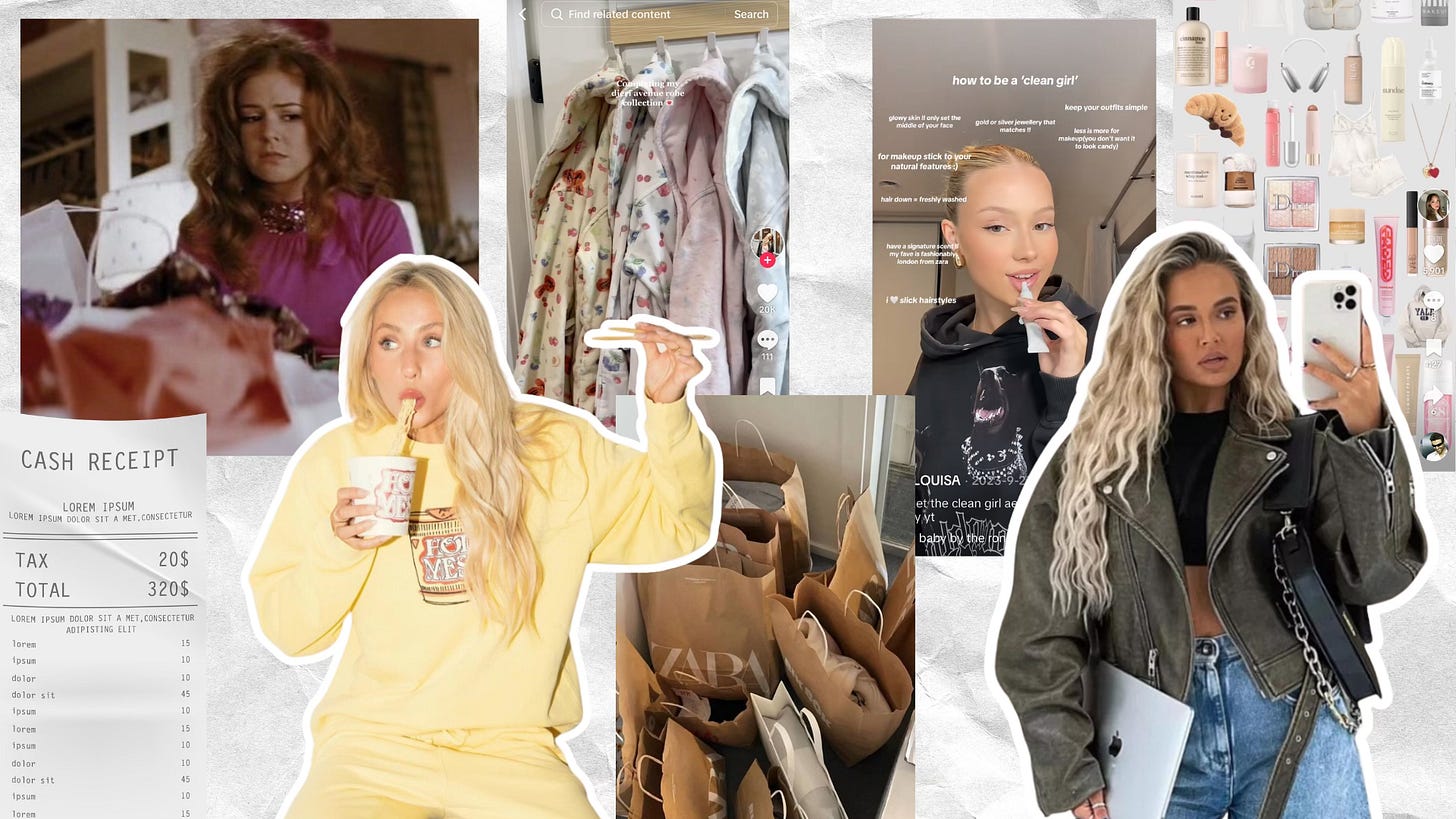
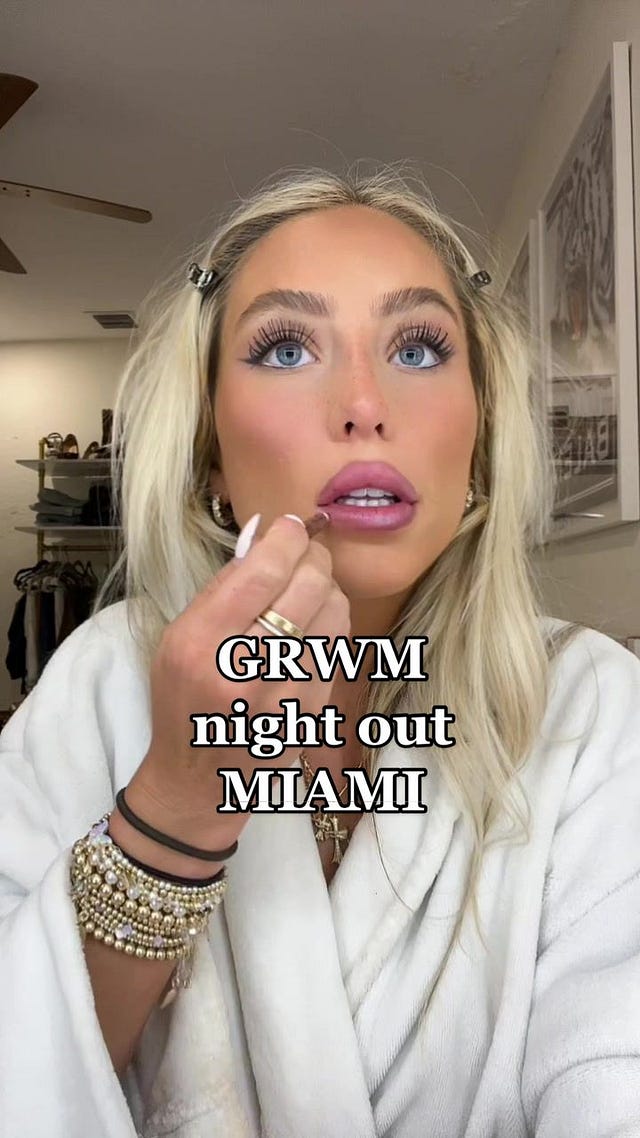
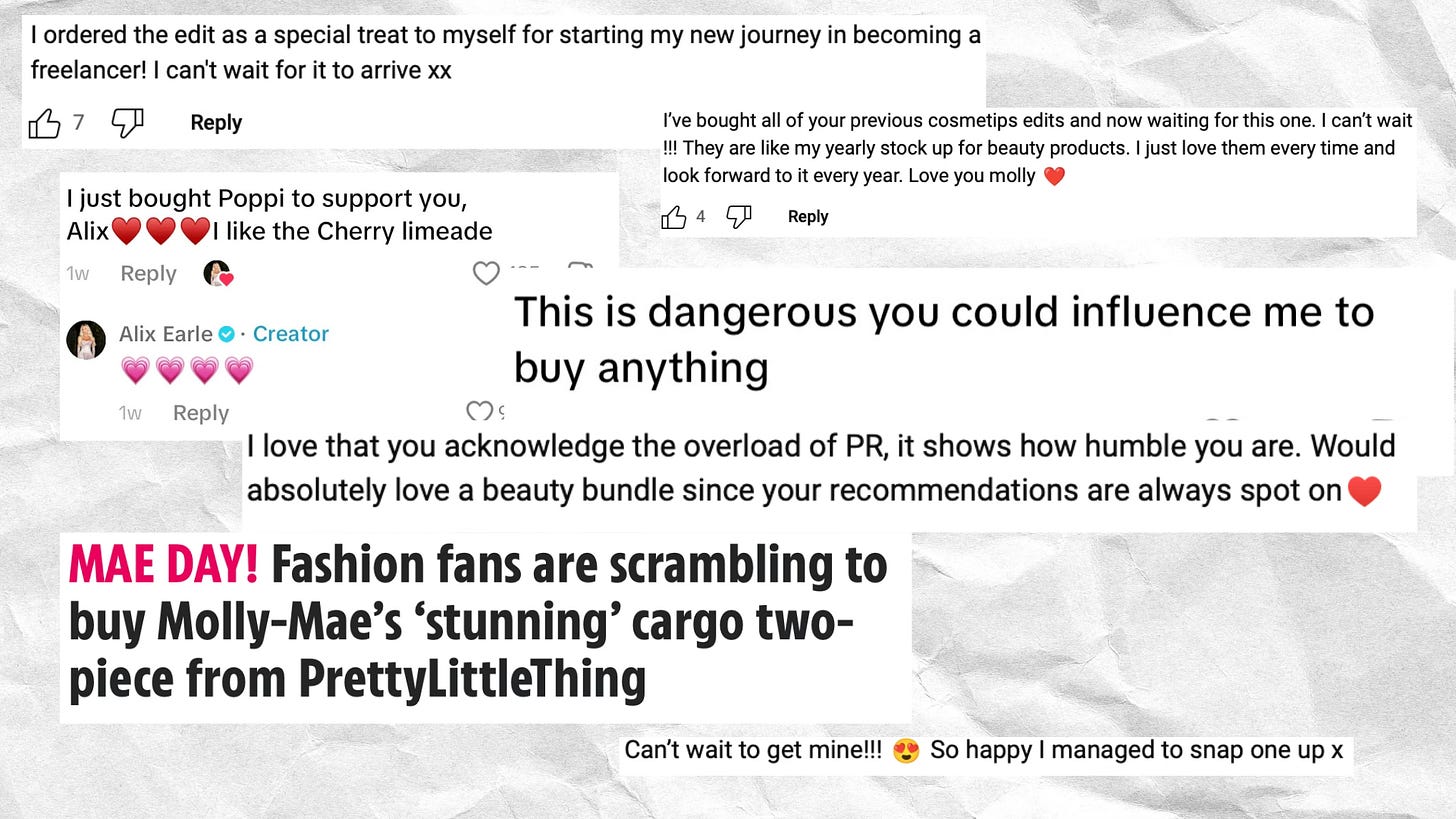

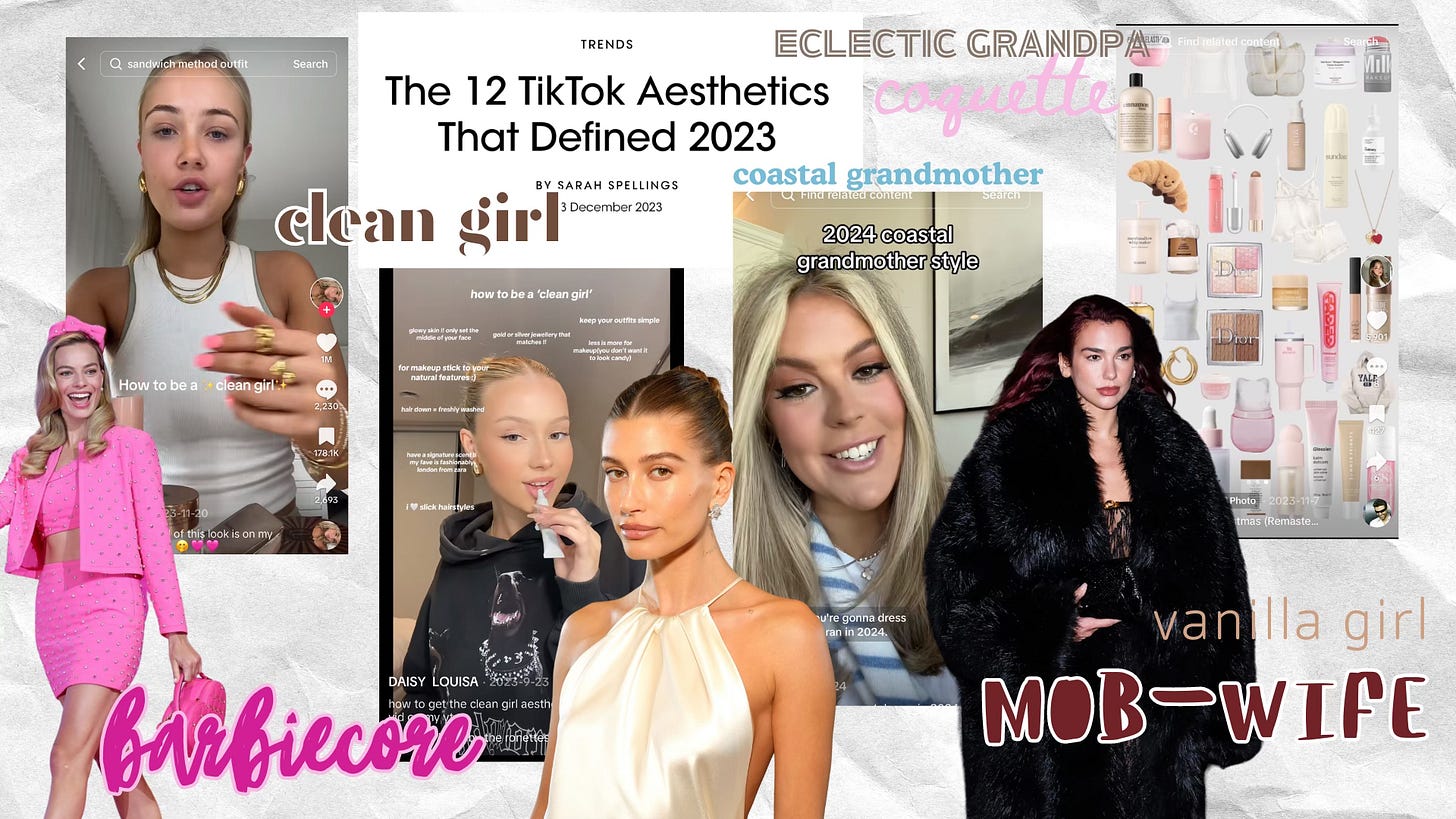
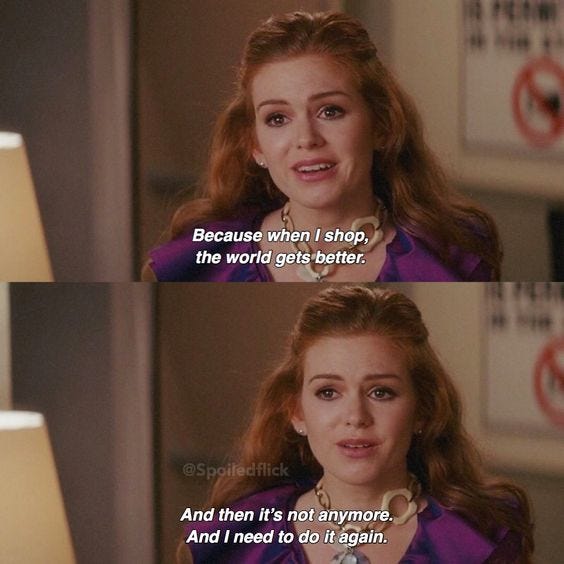




"It appears that one of social media’s worst symptoms is depriving us of our individuality, and more significantly, the confidence to embrace ourselves." Yes to this! And to the whole post!
Even as someone who doesn't do socials (Substack is it at this point), everything in your piece still rang true. It's made me realise a bit better that so much of this attitude is generally/ increasingly part of our lives, and how social media turns it up to 11 before churning it back out into other media forms.
I can't remember where I've picked up this phrase but it's something like "external items won't fix internal problems". If I have an urge to buy something this helps me figure out if I really need it or if I actually need to have a little sit down and journal. I could go on and on but I'll stop there! 💛
Ella this is SO GOOD. Your deep dives (like Barbie + Betty too!) are so well written and thought out. I feel the same way about so many things. I dabbled in influencer life for about a year during the pandemic (of course, lol) and being on the back end of things like LTK is WILD. It’s constantly pushing products and trends, and affiliate commissions are literal pennies. It’s impossible if you don’t have a massive audience. I was also in the home space, which was challenging too. I felt like I needed to buy more stuff to keep up, and it was a vicious cycle. Thank you for sharing!! 🤍